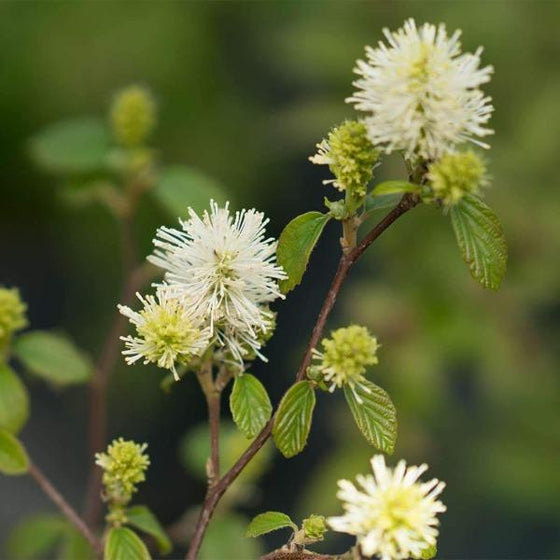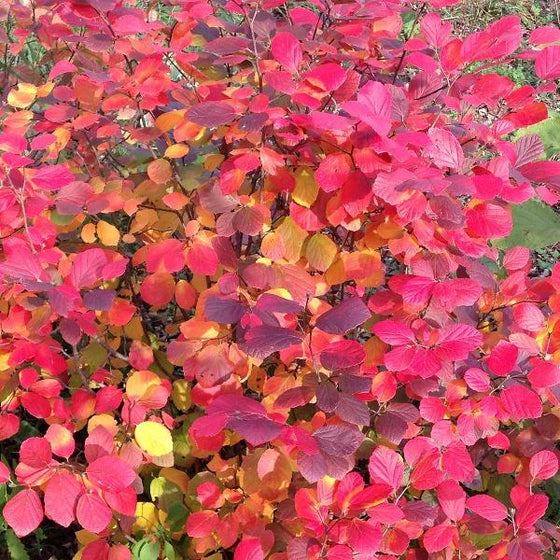
Images Depict Mature Plants
Legend of the Fall® Fothergilla for Sale Online
Legend of the Fall® Fothergilla is a stunning deciduous shrub known for its vibrant multi-season appeal, making it a standout addition to any garden. In early spring, this Fothergilla produces charming, bottlebrush-like clusters of fragrant white flowers, attracting pollinators and adding a delightful burst of color before the foliage emerges. As the growing season progresses, its lush green leaves provide a rich backdrop for other garden blooms. However, it is in fall that Legend of the Fall® Fothergilla truly lives up to its name, displaying a spectacular mix of fiery red, orange, and yellow foliage, bringing an extraordinary splash of color to the landscape when many other plants begin to fade.
Legend of the Fall® Fothergilla grows to a manageable height of 3 to 5 feet with a similar spread, making it ideal for use in mixed borders, foundation plantings, or as a colorful specimen plant. Its compact, mounding form ensures it fits perfectly in smaller garden spaces while providing significant visual impact. This shrub is adaptable to a variety of soil types, thriving in well-drained, slightly acidic soils, and performs best in full sun to partial shade. Its ability to withstand a range of environmental conditions, including occasional drought once established, makes it a low-maintenance option for gardeners seeking beauty and reliability in their landscape.
In addition to its stunning aesthetic qualities, Legend of the Fall® Fothergilla is also deer-resistant, meaning it is less likely to be damaged by browsing wildlife. This makes it a practical and attractive choice for gardens in deer-prone areas. The shrub's early flowers provide nectar for pollinators such as bees, while its dense branching offers cover for birds and other small wildlife. With its multi-season interest, easy care requirements, and spectacular fall color, Legend of the Fall® Fothergilla is a must-have for gardeners looking to create a dynamic, colorful garden that delights throughout the year.

| Hardiness Zone: | 5-9 |
|---|---|
| Height: | 4 to 5 Feet |
| Width: | 4 to 5 Feet |
| Classification: | Deciduous shrub |
| Sunlight: | Full sun to part shade, best color is in full sun |
| Habit: | Upright habit |
| Foliage: | Dark green in spring, reds yellows and oranges in fall |
| Flower: | White, fragrant bottle-brush shaped blooms in spring |
| Uses: | Mass planting, informal hedges, layering under trees, naturalistic gardens |
How to Care for Legend of the Fall® Fothergilla
When purchasing Fothergilla Legend of the Fall, be sure to read the recommended planting and care instructions to ensure a successful transition to its new home.
How do I Plant Fothergilla Legend of the Fall Plants?
Planting Legend of the Fall® Fothergilla starts with selecting the right location to support its vibrant growth and multi-season appeal. Choose a site that provides full sun to partial shade, as Fothergilla performs best with at least 4 to 6 hours of sunlight per day, which will help it develop its stunning fall foliage colors. The soil should be well-drained and slightly acidic for optimal growth; consider amending the planting area with compost or organic matter if the soil is heavy clay or sandy. Begin by digging a hole that is twice as wide and as deep as the root ball. Place the plant in the hole so that the top of the root ball is level with the surrounding soil. Backfill with a mix of native soil and compost, then water thoroughly to help the soil settle and establish good root contact. After planting your Legend of the Fall® Fothergilla, consistent care during the first growing season is essential for healthy establishment. Water deeply and regularly to keep the soil consistently moist but not waterlogged—usually about once or twice a week, depending on rainfall and weather conditions. Adding a 2-3 inch layer of mulch around the base of the plant will help retain soil moisture, regulate temperature, and suppress weeds. Be sure to keep the mulch a few inches away from the stems to prevent rot. If planting multiple shrubs for a border or hedge, space them about 4 to 6 feet apart to allow room for their mature spread. With proper planting and care, Legend of the Fall® Fothergilla will reward you with fragrant spring blooms and a spectacular display of red, orange, and yellow foliage in the fall, adding beauty and diversity to your garden throughout the year.
How Do I Water Fothergilla Legend of the Fall?
Watering Legend of the Fall® Fothergilla properly is crucial to support its lush foliage, beautiful blooms, and vibrant fall colors. During the first growing season, it is essential to water regularly to help establish a strong root system. Water deeply once or twice a week, depending on soil moisture and weather conditions, making sure the soil remains consistently moist but not waterlogged. Deep watering encourages the roots to grow down into the soil, improving drought tolerance over time. To check if your Fothergilla needs water, feel the top 2 to 3 inches of soil—if it’s dry, it’s time to water again. It is best to water in the morning, allowing the plant to absorb moisture throughout the day while reducing the risk of fungal issues. Once established, Legend of the Fall® Fothergilla becomes more drought-tolerant but will still benefit from supplemental watering during hot, dry periods, especially in the summer. The key is to maintain consistent moisture, particularly when the plant is producing blooms in spring and when it starts preparing for its stunning fall display. Adding a 2-3 inch layer of organic mulch around the base of the plant helps retain soil moisture, regulate temperature, and reduce evaporation, ensuring that your shrub remains healthy and hydrated. Be sure to keep the mulch a few inches away from the stems to prevent rot. With proper watering practices, your Fothergilla will thrive, showcasing fragrant spring flowers and an impressive array of fall colors that enhance the beauty of your landscape.
How do I Fertilize Fothergilla Legend of the Fall Shrubs?
Fertilizing Legend of the Fall® Fothergilla is an important step to ensure that it produces lush foliage, abundant blooms, and vibrant fall color throughout the growing season. The best time to fertilize is in early spring, just as new growth begins. Use a slow-release, balanced fertilizer formulated for flowering shrubs, such as a 10-10-10 or 12-4-8 blend, which provides essential nutrients like nitrogen, phosphorus, and potassium to support healthy growth and flower production. Spread the fertilizer evenly around the base of the shrub, extending out to the drip line, but be careful to keep it at least 6 inches away from the stems to avoid root burn. After applying the fertilizer, water thoroughly to help the nutrients soak into the soil and reach the roots. For gardeners who prefer a more organic approach, Legend of the Fall® Fothergilla can benefit from the addition of compost or well-aged manure, which naturally enriches the soil and gradually releases nutrients. Apply a 1-2 inch layer of compost around the base of the plant in early spring to enhance soil quality and support ongoing growth throughout the season. Mulching with organic materials such as shredded bark or leaves also helps retain moisture, regulate soil temperature, and slowly improve soil fertility. Avoid over-fertilizing, as too much nitrogen can lead to excessive leafy growth at the expense of blooms and fall color. By providing the right balance of nutrients, your Fothergilla will thrive, producing fragrant spring flowers and a spectacular display of red, orange, and yellow foliage in the fall, adding year-round interest and beauty to your garden.

How do I Prune Fothergilla Legend of the Fall Shrubs?
Pruning Legend of the Fall® Fothergilla is a straightforward task that helps maintain the shrub's natural shape, encourage healthy growth, and promote better flowering. The best time to prune Fothergilla is right after it finishes blooming in late spring or early summer. During this time, you can remove any dead, damaged, or diseased branches to improve the overall health of the plant. Use clean, sharp pruning shears to make precise cuts just above a healthy bud or branch junction. This type of light pruning will also help shape the shrub, ensuring it maintains its attractive, mounded form without becoming overly dense or unruly. If Legend of the Fall® Fothergilla becomes too large or outgrows its designated space, you can also perform a more selective thinning of older branches. Removing a few of the oldest stems at ground level will help improve air circulation and encourage new growth from the base, which helps maintain the plant's vigor. However, avoid heavy pruning, as Fothergilla has a slow growth rate and can take time to recover from drastic cuts. Additionally, it’s important not to prune in late summer or fall, as this can remove the buds that will produce the next spring’s blooms and reduce the intensity of the stunning fall color display. With regular, light pruning, Legend of the Fall® Fothergilla will thrive, offering fragrant spring flowers and a breathtaking array of autumn hues, making it a standout feature in your landscape year-round.






















